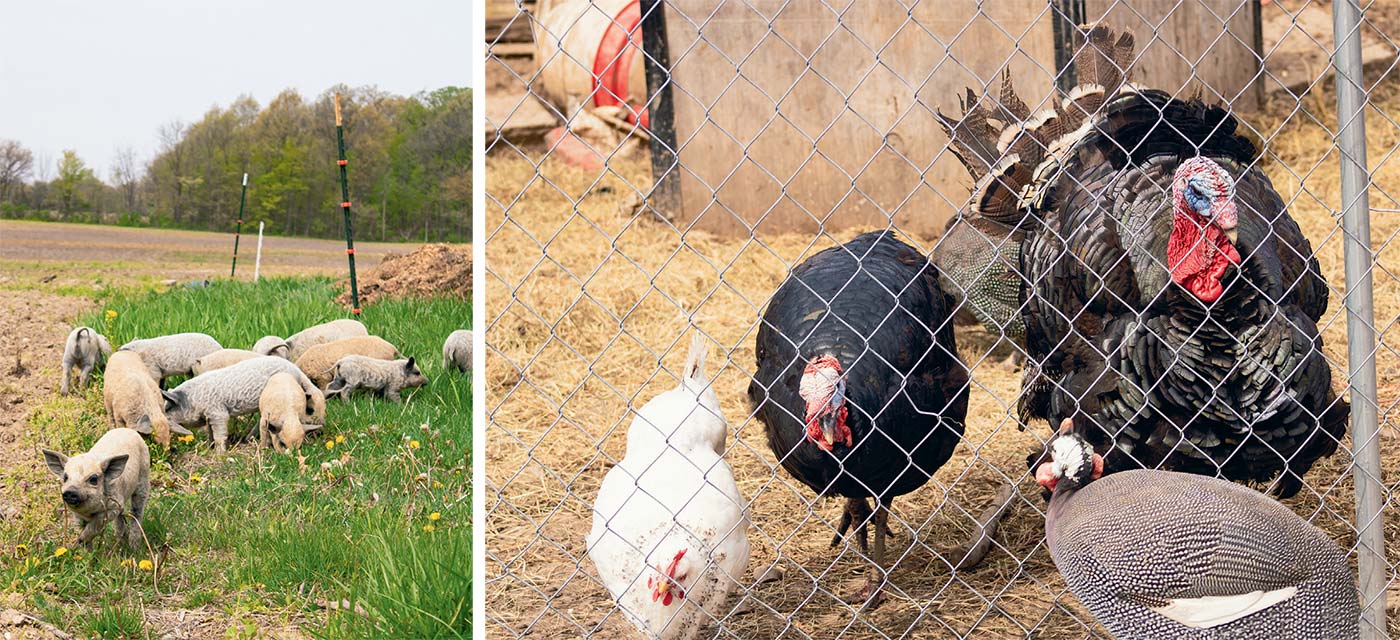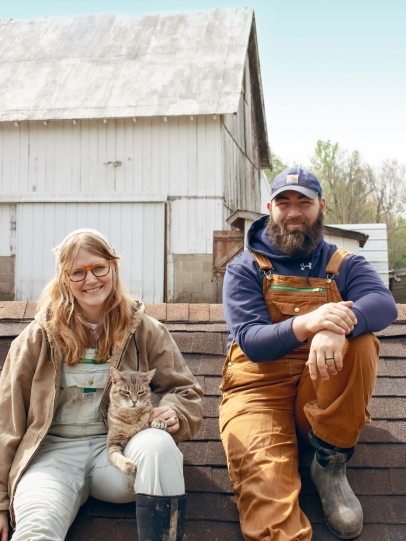Growing in Suburbia
The more our precious land is paved over, the less local food is available.
When I picked up the phone and my husband started off by saying “First of all, I’m OK,” I knew it wouldn’t be good news.
My husband, Warren, and I are working on restoring my great-grandmother’s farm in Westfield, just north of Indianapolis, using the principles of permaculture. These include self-sufficiency, closed-loop systems for waste, creatively using and responding to change as well as caring for others and the Earth.
ROOTS
My family has deep roots on this land. My maternal great-grandmother, Rachel Emma Barker, purchased part of the land with the money she had earned by working as a nurse, adding to the land my greatgrandfather had already purchased. They passed it down to their daughters—my grandmother Leanna Kathryn and her sister Mary Elizabeth—and it has been in my family now for more than 160 years.
I did not grow up in Westfield but in South America, on a dairy farm in rural eastern Bolivia, in a little town called Santiago de Chiquitos. My parents, both Quakers from Hamilton County, moved there independently and raised children and cows on a farm called Panorama, where they still reside. As a little girl I milked cows, pulled weeds, mucked the calf pen and sold what I would tell the tourists was the best yogurt south of the Equator.
Every year or two we would come to the States and visit family, staying with my grandparents in Westfield. I especially remember how my grandmother would drive me around in her white Subaru telling me how all the houses popping up were too close together. She would tell me stories about her father, born in the 1860s, driving around with her and saying, “Look at all this land taken out of cultivation.”
RESPONDING TO CHANGE
Warren is a Navy veteran and we met in the Jemez Mountains of New Mexico in 2020. On our third date, we drove around looking at undeveloped land, talking about what we could do with some space of our own using his studies in land use optimization and restoration and my farm upbringing. Our conversations since have often highlighted the importance of good local food in building a community.
We moved into the old yellow farmhouse in late 2021. We brought our four chickens—Amy, Beth, Meg and Jo, named for the protagonists from Little Women—in the back of a U-Haul trailer along with a lot of big dreams about dairy cows, vast gardens and keeping a nearly 80-acre farm on the edge of the city from being sold off and torn down by developers.
Soon after moving in, we met Lynsey Johnston, founder of Peaceful and Practical Edible Gardens, at a winter sowing class she was teaching at her home. We immediately felt a connection with Lynsey sharing many of the same environmental ideals. She is a believer of using permaculture and her knowledge of local climates to help build successful and sustainable foodscapes. Her expertise continues to educate us on the plants to be sown each season and how to rebuild the soil quality after years of row-cropping have depleted its nutrients. Lynsey is continually providing creative solutions and finding ways to farm more sustainably.
When Warren called me on that fateful day, he had been out feeding the animals and had just gone back inside for a second cup of coffee. All of the sudden, Warren heard the freight train sound of the wind, turned around, and then watched through the kitchen window as most of the lean-to and half of the barn roof flew through where he had been standing moments before, then bounced off the well pump and gutters and smashed through the electric fence before crash-landing in the north field. It was incredible he wasn’t hurt. If we had had our animals indoors rather than out to grab the first few bites of spring grass, I’m not sure how many of them would have survived.
The feed and hay stored in the now-destroyed lean-to were all ruined. Since our animals have access to pasture and are not permanently confined indoors, our only casualty was the ram, Wooliam, who unfortunately ate a stray roofing nail. Our cows sheltered upwind from the barn and our hardy pigs managed the extreme weather that followed without any issues. We believe our implementation of permaculture practices greatly minimized the damage and death caused by this storm.
Since the storm we’ve been pivoting from garden planning to building secondary shelters for our animals and putting up temporary fencing to replace what was lost. We are figuring out how to make it work and, because we already had a plan in place, we have been able to adapt it to our new situation rather than start from scratch.
MINIMIZE WASTE AND COST
Permaculture is all about making do, working with what you have and finding creative solutions by experimenting and testing things out.
We have worked to find ways to improve the soil by using heritage breeds of farm animals, which are resistant to disease and extreme weather as well as generally more resilient and self-sufficient. Every farmer rotates through pasture, but Warren and I have been especially drawn to the Greg Judy method, which prioritizes regenerative agriculture and sustainable ranching via intensive rotational grazing, using mixed herds of sheep, pigs and cattle to improve the soil quality and the overall health and well-being of the animals, since they are end hosts for each other’s parasites.
INTEGRATE
We are growing hardier and varied species on the property. If one crop fails, it is not catastrophic because there is always another that thrives and takes its place. Lynsey plants with careful consideration for how the different plant species will impact each other and give a variety of flavor.
We prioritize hardiness, resilience and self-sufficiency with our animals, but it is a learning curve. We started out with broad-breasted turkeys, finding they grow so quickly their feet will break under their own weight. Both for their sake and ours we are switching to smaller, slower-growing birds such as Heritage Black Turkeys and Bourbon Reds.
The pigs (Doris, Boris and Bertha, with their offspring) are Mangalitsa mixes, a slower-growing species sometimes known as wooly pigs originating from Hungary. They are hardy enough to be outdoors year-round and can handle the temperature swings of Indiana. We have been experimenting with them by having them organically till the soil where our gardens are, taking soil samples before and after. The sows can farrow in the open with minimal shelter, allowing us to plan for them to eventually manage the overgrown wooded areas on our property by tilling and eating the vines and scrub that compete with the trees.

Want to learn more about permaculture and growing your own foodscapes? Reach out to Lynsey Johnston at PeacefulAndPracticalEdibleGardens.com
INTEGRATED PEST MANAGEMENT
Our guinea fowl and chickens provide fabulous organic pest management. Guinea fowl are great at preying on ticks, lowering the risks of disease for us and our other animals. The chickens go through the cow pies, tearing them apart, removing the flies and their larva and helping to spread the manure with their feet, allowing it to become compost.
Our livestock guardian dogs, Tala and Wheeler, work hard to keep the coyotes and trespassers out, staying between the barn animals and the fence. The contrasts between their fierce guard behavior and their love and affection for us and the other animals always makes me smile.
INTERACTION AND OBSERVATION
In the year and a half we have been on the farm, we have noticed different indicator species showing up. We are using them as visual markers for the effectiveness of our regenerative farming practices. We’ve spotted red squirrels and chipmunks where there had been none, and an increased presence of deer. This indicates squirrels and chipmunks now have a source of insects and small organisms that are part of their food cycle and for the deer, a higher quality forage attracts them to our area. Last summer when we processed the last batch of turkeys, it was really fascinating to open their crops and see that they were stuffed full of berries, grass and insects. To me, they serve as examples of the progressive transformation of the land.
SELF-REGULATION AND FEEDBACK
Things are changing faster than ever with agricultural taxes doubling and the pressure increasing for the last few farms in suburbia to be sold so more subdivisions can be built. The more our precious land is paved over, the less local food is available. The more expensive life gets, the harder it will be for people to raise their own food or buy it locally. Local food should be the norm, not a luxury item. I don’t have the answer or what the outcome will be, or even whether a sale might be necessary, but we will continue to do what we do trying to keep the farm alive and build a sustainable life.
For us, the ability to cook meat and produce that we grow ourselves, and knowing what the plants and animals went through on their way to our plate, is worthwhile. Knowing our animals live happy lives surrounded by sunlight and grass is important to us and sharing our knowledge with our friends, neighbors and family continues to be our mission in life. There is no price that can be put on that, and no matter what happens, we will never give up on that dream.
SUCCESS MEASURED IN GENERATIONS
Permaculture is about caring for the Earth and its inhabitants and sharing the results. It is a slower system of farming that considers the small details, seeking to minimize negative impact even if that might earn a greater profit in the short term. It is a form of stewardship where you consider what is best in the long run for the land, plants and animals you oversee, and then work your hardest to make it happen. You care for your charges and fix what is broken, keeping in mind that successful farming isn’t measured in months or years, but in generations and in what you can leave behind for those who come after you.
MANAGING WASTE STREAMS IN SUBURBIA
Did you know you could take your cardboard and make “lasagna gardens” by layering earth, compost and cardboard waste? You can compost most of your food waste, all your grass clippings and fall leaves, and create wonderful fertilizer for your gardens.
Did you know pigs and chickens are omnivores? We now have no food waste on the property; it almost all goes straight to their food! Between that and the compost heap, we have a closedloop system—which means that even if something sours or spoils, it is still eventually nourishing us. We still have trash bins, but the amount in them keeps getting smaller.





